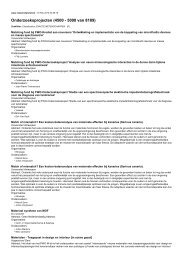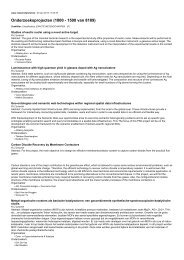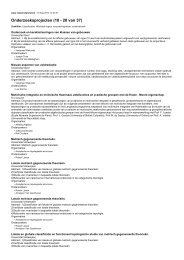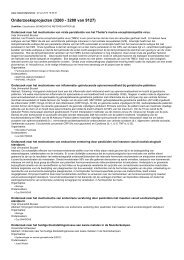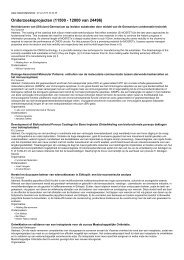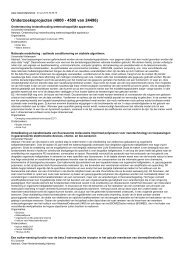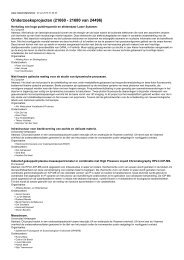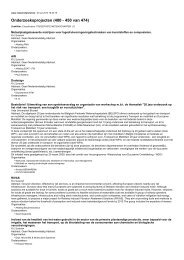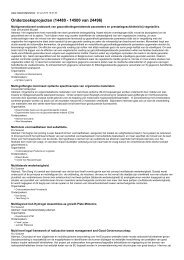Research projects (1 - 500 of 2917)
Research projects (1 - 500 of 2917)
Research projects (1 - 500 of 2917)
Create successful ePaper yourself
Turn your PDF publications into a flip-book with our unique Google optimized e-Paper software.
European Muslims and the End <strong>of</strong> Life. Turkish and Moroccan Attitudes towards Suffering, Dying and Mourning in<br />
Antwerp, Belgium<br />
K.U.Leuven<br />
Abstract: No English Abstract<br />
Organisations:<br />
• <strong>Research</strong> Unit Theological Ethics<br />
<strong>Research</strong>ers:<br />
• Bert Broeckaert<br />
Caput Iohannis in Disco or St John's Head on a Platter (Johannesschüssel): Object, Context, Medium, Roots. Towards an<br />
Iconology <strong>of</strong> the head in the Middle Agnes and the early Modernity, between North and South.<br />
K.U.Leuven<br />
Abstract: No English Abstract<br />
Organisations:<br />
• Art History<br />
<strong>Research</strong>ers:<br />
• Barbara Baert<br />
Mapping the Antwerp-Brussels-Oudenarde tapestry complex (1600-1700) viasocial network analysis.<br />
K.U.Leuven<br />
Abstract: No English Abstract<br />
Organisations:<br />
• Art History<br />
<strong>Research</strong>ers:<br />
• Koenraad Brosens<br />
This project aims to elucidate the interdependency <strong>of</strong> music analysis and music historiography through metamethodological<br />
reflection and case studies from twentieth-century music. The study will be based on: An in-depth<br />
discussion <strong>of</strong> the way analysis is i<br />
K.U.Leuven<br />
Abstract: No English Abstract<br />
Organisations:<br />
• Musicology<br />
<strong>Research</strong>ers:<br />
• Mark Delaere<br />
Authority and Social Interaction in Graeco-Roman Egypt.<br />
K.U.Leuven<br />
Abstract: No English Abstract<br />
Organisations:<br />
• Ancient History<br />
<strong>Research</strong>ers:<br />
• Mark Depauw<br />
Reform and the Bishop: Episcopal Attitudes towards the Administration and Reform <strong>of</strong> Religious Communities during the<br />
Central Middle Ages (Ecclesiastical Province <strong>of</strong> Rheims, c. 900−c. 1100).<br />
K.U.Leuven<br />
Abstract: <strong>Research</strong> into the phenomenon <strong>of</strong> the reform <strong>of</strong> the medieval Church in general and <strong>of</strong> religious communities in particular has stood at the<br />
forefront <strong>of</strong> historical scholarship for a considerable time. However, until recently, the study <strong>of</strong> reform was characterized by the prevalence <strong>of</strong> a<br />
dominant interpretive framework. The almost revolutionary changes in the institutional Church and in Christian life from c. 1050 onwards, on the one<br />
hand, have been explained by a top-down model in which local reform initiatives are considered to have derived directly from the increasingly<br />
centralized power <strong>of</strong> the papacy. On the other hand, the manifold phases <strong>of</strong> 'renewal' typical for monastic - and to a lesser degree canonical -<br />
communities during the tenth and eleventh centuries have predominantly been interpreted by focusing on the influence <strong>of</strong> specific 'reform centres',<br />
the activities <strong>of</strong> their charismatic abbots and the spread <strong>of</strong> their consuetudines. The local episcopacy, however, when it is at all disc<br />
Organisations:<br />
• Medieval History<br />
<strong>Research</strong>ers:<br />
• Brigitte Meijns<br />
Exploring the Crisis Years: Stratification and Social-Economic Transformation in the Eastern Mediterranean during the<br />
Bronze - Iron Age Transition (1200-950.B.C.)<br />
K.U.Leuven<br />
Abstract: 1200 B.C. resonates as one <strong>of</strong> those symbolic dates in history; its importance lies in its position at the beginning <strong>of</strong> a phase <strong>of</strong> crucial<br />
change. In the Eastern Mediterranean, the decades following 1200 B.C. are a period <strong>of</strong> crisis during which significant Aegean, Cypriot, Anatolian,<br />
Levantine and Egyptian centres were devastated (Dothan & Dothan 1992; its importance lies in its position at the beginning <strong>of</strong> a phase <strong>of</strong> crucial<br />
change. In the Eastern Mediterranean, the decades following 1200 B.C. are a period <strong>of</strong> crisis during which significant Aegean, Cypriot, Anatolian,<br />
Levantine and Egyptian centres were devastated (Dothan & Dothan 1992; Gitinet al. 1998; Oren 2000). The Bronze Age political and economic<br />
system collapsed and the aforementioned region underwent pr<strong>of</strong>ound transformations. Failed harvests, food shortages, floods, earthquakes and fire<br />
destructions are all mentioned in contemporary literary sources. All these can be considered as partial explanations for the complex p<br />
Organisations:<br />
• Near Eastern Studies<br />
<strong>Research</strong>ers:<br />
• Joachim Bretschneider<br />
Under the spell <strong>of</strong> learning: The learning society as challenge for the public role <strong>of</strong> school, university and family<br />
education.<br />
K.U.Leuven



